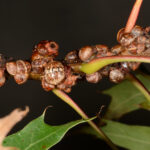Kermes Scale
Scale Insects
Kermes Scale (Kermes ilicis) is a tiny insect that belongs to the family Kermesidae. It is a type of scale insect that feeds on the sap of trees and shrubs and is considered a pest in many areas. The insect gets its name from the bright red or yellow-orange colored waxy coverings that it produces to protect its body.
Kermes Scale is native to the Mediterranean region and is commonly found in Europe and North Africa. It was introduced to North America in the late 1800s and has since become established in many areas. The insect is most commonly found on oak trees but can also be found on other hardwoods such as elm, maple, and holly.
Kermes Scale feeds on the sap of trees, which can weaken the plant and make it more susceptible to other diseases and pests. The insect excretes a sticky honeydew which can attract other pests such as ants and promote the growth of sooty mold. The damage caused by the scale insect can also reduce the growth and overall health of the tree.
Control of Kermes Scale can be achieved through the use of insecticides. However, it is important to carefully follow the instructions and application guidelines to avoid harming other beneficial insects or the environment. Physical removal of the scale insects can also be effective, but this method may not be feasible for larger trees.
In order to prevent an infestation of Kermes Scale, it is important to monitor trees for signs of the insect and to take action if any are found. This can include removing infected branches and controlling the populations of other pests that may be attracting the scale insects to the tree. Regular inspections and proper tree maintenance can help to keep Kermes Scale populations in check and maintain the health of the tree.



